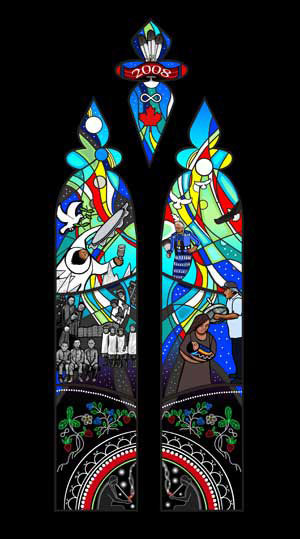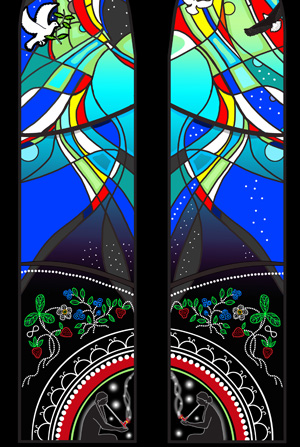Remembering the Past: A Window to the Future
The stained glass window "Giniigaaniimenaaning" (Looking Ahead) in Parliament commemorates students and their families
On this page:
About the stained glass window
On November 26, 2012, the Government of Canada commemorated the legacy of Indian Residential Schools through the dedication of a stained glass window in Parliament. The window is permanently installed in Centre Block on Parliament Hill.
Designed by Métis artist Christi Belcourt and translated into glass by Vision Art Stained Glass Studio, the window commemorates the legacy of Indian Residential Schools and the Prime Minister of Canada's historic Apology to former students of those schools and their families.
The artist's design for the window was chosen unanimously by a selection committee comprised of leading Indigenous art experts and former Indian Residential School students.
In November 2012, the window was presented to the Honourable Andrew Scheer, Speaker of the House of Commons, by the Honourable John Duncan, Minister of Aboriginal Affairs and Northern Development.
While the stained glass window is a visible reminder of truth and healing, it is also a window to a future founded on reconciliation and respect.
Healing, reconciliation and renewal
First Nations, Inuit and Métis, alongside other Canadians, are participating in truth telling, healing and reconciliation activities.
Cultural practices and languages are being revitalized, and a sense of optimism and hope for the future is building.
"I am filled with optimism…a new day has dawned, a new day heralded by a commitment to reconciliation and building a new relationship with Inuit, Métis, and First Nations."
All Canadians have a role to play in reconciliation and renewal. Knowledge of our shared past, mutual respect and the desire to move forward together will contribute to a stronger Canada for all of us.
"The reconciliation process is not an Aboriginal process, I would argue, but rather time for reconciliation for all Canadians and a step forward toward improved relationships and increased opportunities between Aboriginals and non-Aboriginals."
Giniigaaniimenaaning (Looking Ahead)
Summary
By Christi Belcourt
"The story begins in the bottom left corner of the glass, with your eye moving upwards in the left panel to the top window, and flowing down the right window to the bottom right corner. The glass design tells a story. It is a story of Aboriginal people, with our ceremonies, languages, and cultural knowledge intact; through the darkness of the residential school era; to an awakening sounded by a drum; an apology that spoke to the heart; hope for reconciliation; transformation and healing through dance, ceremony, language; and resilience into the present day.
The title of the piece is "Giniigaaniimenaaning" translated into English means, "Looking Ahead". The title is in Anishinaabemowin (Ojibway) and includes, within the deeper meaning of the word, the idea that everyone is included and we are all looking ahead for the ones "unborn".
Left glass panel
Top
In 1990, Phil Fontaine, then Grand Chief of the Assembly of Manitoba Chiefs, and later National Chief of the Assembly of First Nations, became one of the first Aboriginal leaders to speak publicly about the abuses he suffered as a child at residential school. The shattered glass represents the breaking of the silence in the 1980s as survivors from all over Canada began to speak openly about what happened to them at the schools. The broken glass also represents the shattered lives, shattered families and shattered communities that resulted from the government policy of forced assimilation. The drum dancer sounds the beginning of the healing. The circles moving up and out from behind the drum represent the transformation that governments and churches made, from taking initial positions of denial, to acceptance, and finally to acknowledgement and admission, paving the way for an apology. The snow falls and the moon glows from a northern sky. The dove with the olive branch brings an offering of hope for the beginning of reconciliation and the renewal of the relationship between Aboriginal peoples and the rest of Canada.
Middle
This section of the window represents the "sad chapter" of the residential schools era, where more than 150,000 children were forcibly removed from their homes and often subjected to unimaginable and horrific abuses. As Prime Minister Stephen Harper stated in the Statement of Apology on June 11, 2008, the objective of the residential schools was to "remove and isolate children from the influence of their homes, families, traditions and cultures." The children shown here are taken from historical photographs, with artist renditions of other children. The building, rendered from a photograph of the Shubenacadie Indian Residential School, is included because often these buildings represented the institutionalized system of abuse and assimilation. Children were not permitted to leave and, therefore, the buildings became their prisons. The lines that cross over the children represent the silencing of the children who were unable to speak about the abuses they were enduring.
Bottom
The ancestor smokes in the sacred lodge. From the west (represented by the button blanket motif) to the east (represented by the sky dome motif), our ceremonies, languages, and traditional knowledge were intact. This section represents the time before residential schools existed. Important ceremonies marking the transition from childhood to adulthood, such as the strawberry fast, were taught and practiced. Harvesting blueberries, learning about medicines and knowledge of plants and animals were passed from one generation to the next. Beadwork and beautiful artwork, reflecting our pride, adorned our clothing and sacred items. The roots represent connection to the earth and to our ancestors. It is expected that, when rendered in glasswork, the colours and white/clear glass circles, or crystals, will give the bottom section an ethereal feel as they will glow from the darkness.
Top glass panel
This section commemorates the official Statement of Apology to former students of Indian Residential Schools on June 11, 2008, by Prime Minister Stephen Harper.
On that day from coast to coast to coast, Aboriginal people gathered in community centres and homes to watch the Prime Minister give the statement, and to watch as their own leaders made their historic responses on the floor of the House of Commons.
Reaction to the Apology ranged from skepticism to gratefulness, marked by tears of relief, that finally the hurt that individuals carried was being acknowledged and an apology was being made. Regardless of how individuals reacted to the Apology, mostly everyone was moved emotionally, as Prime Minister Harper spoke the words, "The Government of Canada sincerely apologizes and asks the forgiveness of the Aboriginal peoples of this country for failing them so profoundly."
In this panel, symbols representing Inuit, First Nations and the Métis Nation are featured alongside the iconic maple leaf. Canada, as represented by the maple leaf, is shown among the Aboriginal icons as a way to symbolize the hope expressed on that day by the Aboriginal leaders in their official response on the floor of the House of Commons. On behalf of all Aboriginal people, Indigenous leaders graciously accepted the apology from the Prime Minister.
Right glass panel
Top
As in the left panel, circles emerge and transform into a fully visible sun. The sun rises and represents not only transformation, but more importantly, as Mary Simon, then President of the Inuit Tapiriit Kanatami (ITK); said in her official reaction on the floor of the House of Commons, "I am filled with optimism… a new day has dawned, a new day heralded by a commitment to reconciliation and building a new relationship with Inuit, Métis and First Nations."
The lines flowing from the sun are meant to convey the concept of moving from the present into the future. The colours embody the colours used within different medicine wheels, sundance and Midewin lodges and the Métis sash (yellow, black, red, white, green, and blue). Together with the left panel, sun and moon represent the cycle of life, seasons, and change.
The jingle dress is a sacred healing dress that is now common throughout North America. In this panel, the jingle dress dancer is an Elder who is a survivor of the residential school. She is dancing for the healing of all the people and for future generations.
Middle
In this section, the colours and lines move us soundly into the present day and thinking about the future. The young mother embraces her baby in a traditional moss bag. The child is back with her mother, as she should be, representing children being raised by their parents and the breaking of the cycle of abuse. Her grandfather sings a traditional song signifying the restoration of songs, dance, ceremonies, and languages.
Within this panel are the following words: Kisakihitin ("I love you" in Cree), Gizhawenamin Niichaanis ("I love you my child" in Anishnaabemowin), Nagligiivagit ("I love you" in Inuktitut), Kesalul ("I love you" in Mi'kmaq). Many victims of residential schools were unable to tell their own children they loved them, and many children never heard those words from their parents. Embedding these words within the glass solidifies the existence and use of Aboriginal languages.
Bottom
The circle is complete. Presently, traditional ceremonies take place throughout the year. The grandmother sits in the lodge smoking her pipe for her grandchildren. Potlach ceremonies take place and Salmon and Sturgeon ceremonies are on-going. The sundance lodges are erected and the Midewin lodges are no longer whispered about but are now out in the open. Puberty ceremonies are being practiced. Traditional knowledge about medicines is being taught. From east to west, the foundations of our cultures are being brought back and made whole. There is hope; there is a new respect for Aboriginal cultures within the rest of Canada as we are witness to our own strength and resilience.
Design within the design
Mother Earth
The land is integral to our being. We consider the land sacred. Although it is not obvious, Mother Earth is the foundation of the stained glass design represented by the shape of a woman.
So many of our traditions, culture and ceremonies, and indeed our very way of life, is based on connection with the land and interconnection with the spirit of the Earth, that it would be remiss to design something concerning our people, without including the earth in some form."
About the artist
Christi Belcourt (born 1966) is a Métis visual artist with a deep respect for the traditions and knowledge of her people. Like generations of Indigenous artists before her, she celebrates the beauty of the natural world while exploring nature's symbolic properties. Following the tradition of Métis floral beadwork, Belcourt paints in dots and uses the subject matter as metaphors for human existence to relay a variety of meanings that include concerns for the environment, biodiversity, spirituality and awareness of Indigenous cultures. For more information on the artist, visit Christi Belcourt's website.
Video
Remembering the Past: A Window to the Future
Transcript: Remembering the Past - A Window to the Future
Stephen Harper: The treatment of children in Indian Residential Schools is a sad chapter in our history. Two primary objectives of the Residential Schools system were to remove and isolate children from the influence of their home, families, traditions and cultures, and to assimilate them into the dominant culture. Indeed, some sought, as was infamously said, "to kill the Indian in the child". Today we recognize that this policy of assimilation was wrong, has caused great harm, and has no place in our country. The Government of Canada sincerely apologizes and asks the forgiveness of the Aboriginal peoples of this country for failing them so profoundly. Nous le regrettons. We are sorry. Nimitataynan. Niminchinowesamin. Mamiattugut.
Narrator: October 2011. The Honorable John Duncan, Minister of Aboriginal Affairs and Northern Development, announces that as a gesture of reconciliation, the Canadian government will commemorate the legacy of Indian Residential Schools with the permanent installation of a stained glass window. It will be installed in the very heart of parliament…in the Centre Block, above the Members' entrance.
John Duncan: A permanent commemoration of the legacy of Indian Residential Schools will encourage all parliamentarians and visitors for generations to come to learn about the history of Indian Residential Schools and Canada's reconciliation efforts.
Narrator: Submissions for the window design came from aboriginal artists across Canada. The design by renowned Metis artist Christi Bellcourt was chosen.
Christi Belcourt: My main concern at all moments throughout the process of designing it was to honour the students in the best way that I could.
Narrator: The task of transforming Christi's design into a glass window falls to Andrew Florczak, of Vision Art Studio in Toronto.
Andrew Florczak: All the glass is cut individually…each piece. So we cut probably about a thousand pieces of glass.
Christi Belcourt: It begins in the bottom left corner in a lodge, where a grandfather is smoking his pipe. This is before residential schools when everything was whole… when everything was intact.
The middle panel of the left hand side is the panel that depicts the residential school era, where 150,000 children were forcibly removed from their families. The children were abused sexually, and abused physically, and mentally.
In 1990, Phil Fontaine was the first national leader to publicly acknowledge that he had been abused in residential schools. There was something that happened when he did it that made the rest of Canada kind of wake up to the idea that this had happened. So within the design there's a shattering of glass. And that represents the shattering of silence and the shattering of lives. Then the drum dancer…the Inuk drum dancer is there. The drum is our heartbeat, and so it's awakening the people. The dove is there as a hope of reconciliation.
In 2008, which is the middle panel, the Government of Canada, Prime Minister Stephen Harper publicly apologized, and our leaders were for the first time able to be on the floor of the House of Commons and respond. As it moves down into the right panel the lines and the colours are meant to bring a feeling of bringing it forward into the future.
The jingle dress is a sacred dress. It's a healing dress and so the jingle dress dancer is there. She's dancing for the future of her grandchildren. The child is now with the mother…no longer being separated…no longer being taken away. She is able to tell her child "I love you". The grandfather in the back is practicing ceremonies and able to pass on that traditional knowledge.
And so the bottom panel is the other half of the circle where the grandmother sits in the lodge and she's smoking her pipe for her grandchildren. And it is a restoration of cultures…a restoration of traditional practices. If we look at the history, we won't repeat it. If we remember history, we'll be able to move forward from it.
John Duncan: It's my great honour and privilege to join you here today, on Algonquin traditional territory for this dedication ceremony. I'd like to acknowledge the former Indian Residential School students who are here with us today, some of whom have travelled great distances from across the country to join with us. Through the official dedication of this window, we honour your experiences and ensure they are never forgotten.
Angie Hazel Crerar (former student): I got very emotional. Looking at it brought back so many memories. I could just visualize all those children that I went to school with for 10 years. To me, it meant more than the apology. The apology was words…but this one was visual.
Noel Starblanket (former student): I'm grateful that they're doing it. Now when the members of parliament, the Prime Minister and cabinet ministers come out of that House of Commons, everyday, they face that window.
Martha Greig (former student): To see that window, it's representing that there is hope.
Francois Paulette: And that that hope will continue with our children and particularly our grandchildren.
Singers: Though it was hard…it's a new day….




